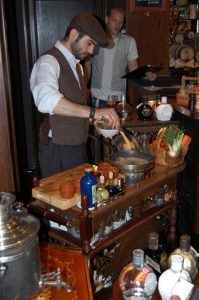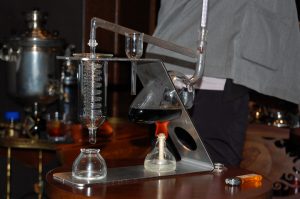In recent years Mozart has gone from strength to strength in UK bars and since the introduction of Mozart Chocolate Bitters earlier this year barely a cocktail competition goes by without an inclusion.
With this in mind Mangrove, the UK distributors, organised a series of Masterclasses across the UK with Mozart’s Brand Ambassador Anna Kruggel. The sessions promised tastings, cocktails, food and education on the brand along with live distilling. BarLifeUK was of course on hand at the London event in Nightjar to bring you all the Mozart-iness.

Whenever we have been to an event at Nightjar the food on offer has been fantastic and this session was no exception with a trolley complete with hob knocking out some lovely prawns cooked in Mozart Dry and chilli to go with our starter cocktail a Tabula Rasa, basically a Mozart twist on a Negroni (recipe below).
Mozart produce 5 distinct brands the Gold (Milk Chocolate), Black (Dark Chocolate), White (White Chocolate) and the two newer brands Dry (Clear Chocolate Spirit) and the Mozart Chocolate Bitters. The chocolate side of these brands involve three main components Cocoa from Ghana, Sugar from Sugar Cane and Bourbon Vanilla from Madagascar, in essence the best of the ingredients out there. The base spirit is to all intents and purposes a fine distillate from sugar cane.
The main ingredient is the Cocoa which, when it is processed further to a chocolate, is put through a method called Conching, a system that was invented by Rudolf Lindt of Lindt Chocolate fame. The method means the Cocoamass is put into form of grinder which then smashes the sugar and fat particles making that smooth texture which you get in good chocolate (rather than that bitty stuff you get with cheap nasty Easter Eggs). It is during this process that one of the Mozart myths is answered. You may have heard people say that Mozart play music to their spirit as it is made however the truth is a bit more interesting than that… Mozart use an unusual conching process where they play music to the Mozart Gold and the sound waves smash the sugar and fat particles rather than a grinder, the music they play of course is Mozart!
I know that you are reading this article wondering when I am going to get to the distilling process for Mozart Dry. You see the Gold, Black and White brands all have their ABV’s in the teens however Dry is 40%, sounds fine apart from the fact that chocolate burns really easily which is why genuine chocolaty based spirits/liqueurs all have their ABV’s low. So, Mozart Distillerie invented a unique form of progressive distilling, where Mozart Dry is directly distilled to 40% without the cocoa being burnt. Well Anna was here and the room full of knowledge seeking bartenders were not going to pass up on the opportunity to find out how it is done. As is o often the case with the most interesting things in life it is a closely guarded secret with even Anna claiming she didn’t know to process – damn!

A big push for Mozart is showing just how well it can work with other flavours. The food and the drinks were fantastic examples of how the various brands in the range can combine to create great tastes. To this end they have worked with a food pairing institute which specialises in showing what flavours work best with each other. They heat up products to a gas to detect the various aromas using lots of fancy technology and then pair these base aromas to similar aromas from other foods and spirits, the more aroma components foods or drinks have in common the better they match. This results in a Food Pairing Tree which is brilliantly useful for anyone wanting to experiment.
To prove just how versatile Mozart is here are a couple of recipes for cocktails we tried on the day for you to have a play with:
Tabula Rasa (by Klaus St. Rainer, Goldene Bar, Munich)
30ml Mozart Dry
20ml Campari
20ml Antica Formula
Orange zest
Build in the glass, like a Negroni
24 Volt Cobbler (courtesy of Nighjar)
10 cranberries
17.5ml Mozart dry
12.5ml Giffard Crème de Mure
35ml French fruity red wine
1/4 squeezed fresh lime
7.5ml vanilla maple syrup
1 dash electric bitters (high strength alcohol infused with Szechuan flower)
Muddle cranberries in Boston glass, and all ingredients and shake and strain into a wine glass on crushed ice, garnish with berries.

